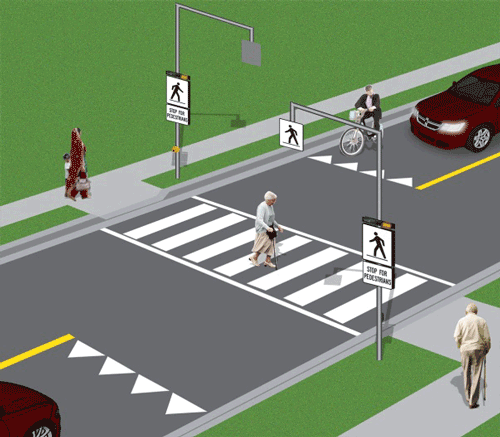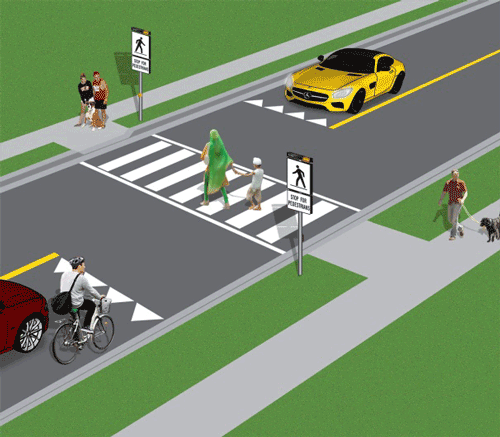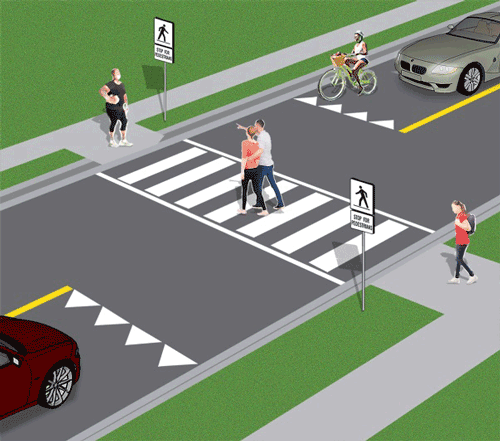Type B Pedestrian Crossovers have signs above and on both sides of the road, pavement markings, and flashing lights that can be activated by pedestrians using push buttons.

Our pedestrian network is growing and connected, making it safer to walk to places like schools and transit.
Sidewalks
Multi-use pathways
Pedestrian crossovers are marked crosswalks where drivers and cyclists must stop for pedestrians intending to cross a road. They can be identified by signs, road markings and sometimes flashing lights. Read our Pedestrian Crossing Guidelines to learn more.
What pedestrians need to know:
What drivers and cyclists need to know:
There are three types of pedestrian crossovers used around Kingston.
Type B Pedestrian Crossovers have signs above and on both sides of the road, pavement markings, and flashing lights that can be activated by pedestrians using push buttons.

Type C Pedestrian Crossovers have signs on the sides, pavement markings, and flashing lights that can be turned on by pedestrians using push buttons.

Type D Pedestrian Crossovers have signs on the sides of the road and pavement markings.

At a signalized pedestrian crossing, pedestrians press a button to activate the walk signal, which is followed by a flashing hand display. Drivers and cyclists must obey the traffic signals and yield to pedestrians and other vehicles on the road.
What pedestrians need to know:
What drivers and cyclists need to know:
There are many different types of pedestrian signals used around Kingston.
Accessible pedestrian signals let people with visual or visual and hearing impairments know when they have the right-of-way to cross at a signalized intersection.
Two audible tones are used to indicate the direction of travel. A cuckoo sound indicates that the pedestrian can cross in the north / south direction and a chirp sound indicates that the pedestrian can cross in the east / west direction. The buttons can also vibrate when the signal is on.
All new intersections are equipped with accessible pedestrian signals. To request these signals at older traffic lights, please submit a service request.
Intersection pedestrian signals
Intersection pedestrian signals help people cross busy roads safely.
Pushing the button activates the traffic signal, which stops traffic and indicates when pedestrians can cross the road. Drivers turning from the side streets are controlled by a stop sign, rather than traffic signals, and they may complete their turn only when the way is clear of both vehicles and pedestrians.
A mid-block pedestrian signal includes traffic signals for main road vehicles and marked pedestrian crosswalks. Unlike an intersection pedestrian signal, there are no side streets at a mid-block pedestrian signal.
Pedestrians press a button to activate the walk signal. All road users must follow regular traffic rules.
Scramble crossings, also known as pedestrian priority crossings, stop all vehicle traffic from proceeding and turning at an intersection, including right-hand turns. This allows pedestrians to cross safely in any direction.
What pedestrians need to know:
What cyclists need to know:
What drivers need to know:
Two-stage crossings feature an accessible waiting area within the refuge island for pedestrians to complete their crossing in two distinct stages.
What pedestrians need to know:
Benefits of two-stage crossings:
Find pedestrian crossing locations on the Walking and Cycling Infrastructure map.
Contact Us
City of Kingston
City Hall
216 Ontario Street
Kingston, ON K7L 2Z3
Canada
contactus@cityofkingston.ca
Phone: 613-546-0000

The City of Kingston acknowledges that we are on the traditional homeland of the Anishinabek, Haudenosaunee, and the Huron-Wendat, and thanks these nations for their care and stewardship over this shared land.
Today, the City is committed to working with Indigenous peoples and all residents to pursue a united path of reconciliation.
Learn more about the City's reconciliation initiatives.